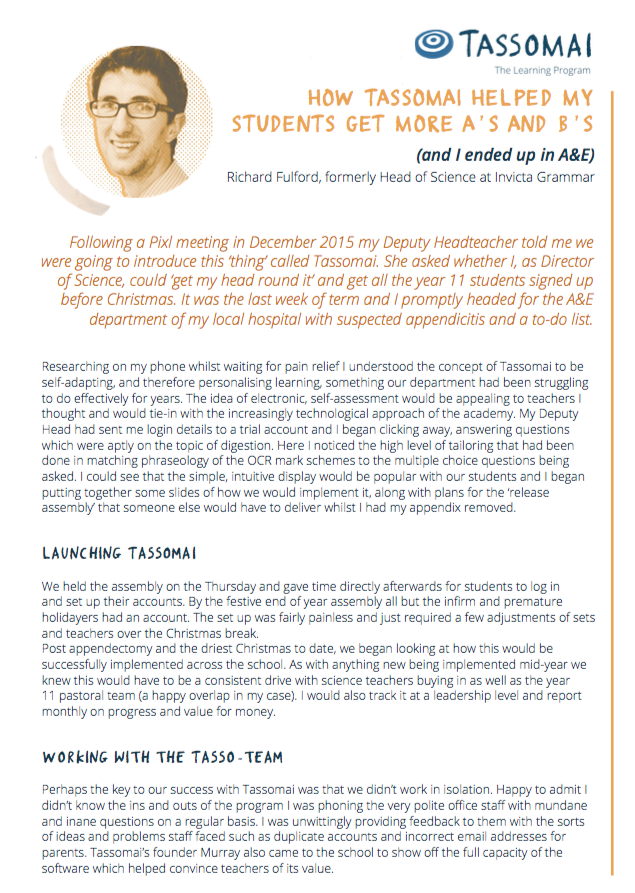How Tassomai helped my students get more A’s and B’s (and I ended up in A&E)
Richard Fulford, formerly Head of Science at Invicta Grammar.
Following a Pixl meeting in December 2015 my Deputy Headteacher told me we were going to introduce this ‘thing’ called Tassomai. She asked whether I, as Director of Science, could ‘get my head round it’ and get all the year 11 students signed up before Christmas. It was the last week of term and I promptly headed for the A&E department of my local hospital with suspected appendicitis and a to-do list.
Researching on my phone whilst waiting for pain relief I understood the concept of Tassomai to be self-adapting, and therefore personalising learning, something our department had been struggling to do effectively for years. The idea of electronic, self-assessment would be appealing to teachers I thought and would tie-in with the increasingly technological approach of the academy. My Deputy Head had sent me login details to a trial account and I began clicking away, answering questions which were aptly on the topic of digestion. Here I noticed the high level of tailoring that had been done in matching phraseology of the OCR mark schemes to the multiple choice questions being asked. I could see that the simple, intuitive display would be popular with our students and I began putting together some slides of how we would implement it, along with plans for the ‘release assembly’ that someone else would have to deliver whilst I had my appendix removed.
Launching Tassomai
We held the assembly on the Thursday and gave time directly afterwards for students to log in and set up their accounts. By the festive end of year assembly all but the infirm and premature holidayers had an account. The set up was fairly painless and just required a few adjustments of sets and teachers over the Christmas break.
Post appendectomy and the driest Christmas to date, we began looking at how this would be successfully implemented across the school. As with anything new being implemented mid-year we knew this would have to be a consistent drive with science teachers buying in as well as the year 11 pastoral team (a happy overlap in my case). I would also track it at a leadership level and report monthly on progress and value for money.
Working with the Tasso-team
Perhaps the key to our success with Tassomai was that we didn’t work in isolation. Happy to admit I didn’t know the ins and outs of the program I was phoning the very polite office staff with mundane and inane questions on a regular basis. I was unwittingly providing feedback to them with the sorts of ideas and problems staff faced such as duplicate accounts and incorrect email addresses for parents. Tassomai’s founder Murray also came to the school to show off the full capacity of the software which helped convince teachers of its value.
Carrots, sticks and number crunching for the SLT
An all encompassing Tassomai initiative had begun, plasma screens praising the week’s highest performers who were rewarded as part of the rewards policy, ‘compulsory catch up’ in form time or lunchtime for those not doing their work. We were able to do this as we assigned half the homework allocation for the rest of the year to Tassomai and half on our more traditional past paper question assignments as well as revision etc. I was the “TassoMinder”, ever present in year assembly, reminding students to do the work regularly and in small chunks. Class teachers were made responsible for their groups and the weekly progress spreadsheet for the cohort was crunched by admin staff before the SLT meeting on the Tuesday evening.
The weekly review, combined with the year 11 monitoring and tracking, showed that we were on course for some encouraging results at GCSE. We were studying the now legacy OCR gateway triple science course, which had almost double the number of specification points compared to AQA triple, we didn’t have time in lessons to deliver skills, exam technique and complete the massive, content heavy course early enough to aid students with meaningful revision. Tassomai provided daily, low stakes, challenging, personalised continuous assessment. This helped students gain confidence which motivated them to further revise and caused a positive spiral effect in the months leading up to the exam.
Less time spent on marking, more time spent teaching
I've focussed so far on the advantages to students, which is of course the primary outcome; however, there were many other positive effects on teachers in what was a severely understaffed department. We were battling with gaps in learning, high expectations for dialogic marking, and everything else that comes with working in an outstanding, high performing grammar school.
Tassomai halved teacher marking in year 11. Halved it. In exchange, staff used Tassomai’s data to see what topics to revise with which students. It allowed more skills and practical revision to occur as AO1 was being covered largely by Tassomai. Yes, staff had to chase students who were lazy, but this happens with pen and paper homework too. Parents were regularly contacted with strengths and weaknesses. This has variable impact dependent on the parenting but it was providing much more regular feedback than we could otherwise offer.
We shared the Understanding Grid at parents’ evenings to pinpoint areas of last minute revision. Every year 11 was using Tassomai. There were of course those who objected; we work with teenagers. However, often their adolescent pedagogical objections were usually cover for the fact they were late starting the course and had left themselves too much to do in such a short space of time and therefore decided they wouldn’t do it. They did do it, in form times and at lunch.
The impact on grades...
Results in science that year jumped 10% A*/A with our triple cohort in each discipline. However, our best improvement was the number of students gaining at least a B in the core and additional course. On a tough spec where grade boundaries reflected a national weakness, students who knew more science benefitted.
I believe Tassomai helped them know more stuff and that it helped teachers teach the students how to apply it to questions and hone exam technique rather than spend time inventing creative knowledge quizzes.
The following year we rolled out Tassomai to our sister secondary schools in the multi academy trust - not just in year 11 but in year 10 too - as we wanted to further embed the idea of using technology to aid continual reinforcement rather than last minute cramming. I left the trust at this point, but believe that Tassomai continues to benefit students in their understanding, teachers in their teaching and the school in terms of results.





















